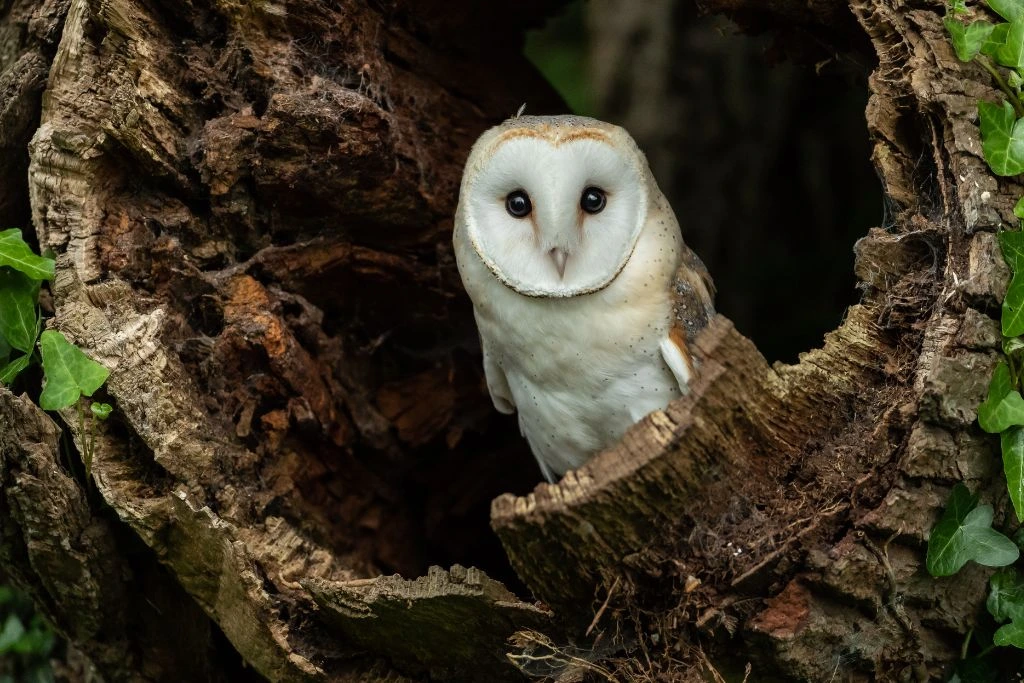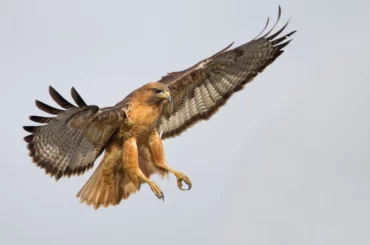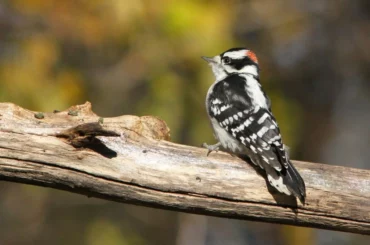Avid bird fans visiting the Lone Star State of Texas will be excited to know that it is home to hundreds of bird species. With such an abundance of feathered friends, are owls indigenous to Texas? Yes, they are! And you’ll be happy to hear that there are 13 types of owls in Texas!
So, does that mean owls aren’t rare in Texas? Yes, in general, they aren’t, but some species are rarer to find, especially if they’re small, silent, or migratory.
To increase your chances of seeing one, you should ask: where do owls live in Texas? The answer depends on the species. Some prefer woody areas, while others live right in your backyard.
1. Great Horned Owl
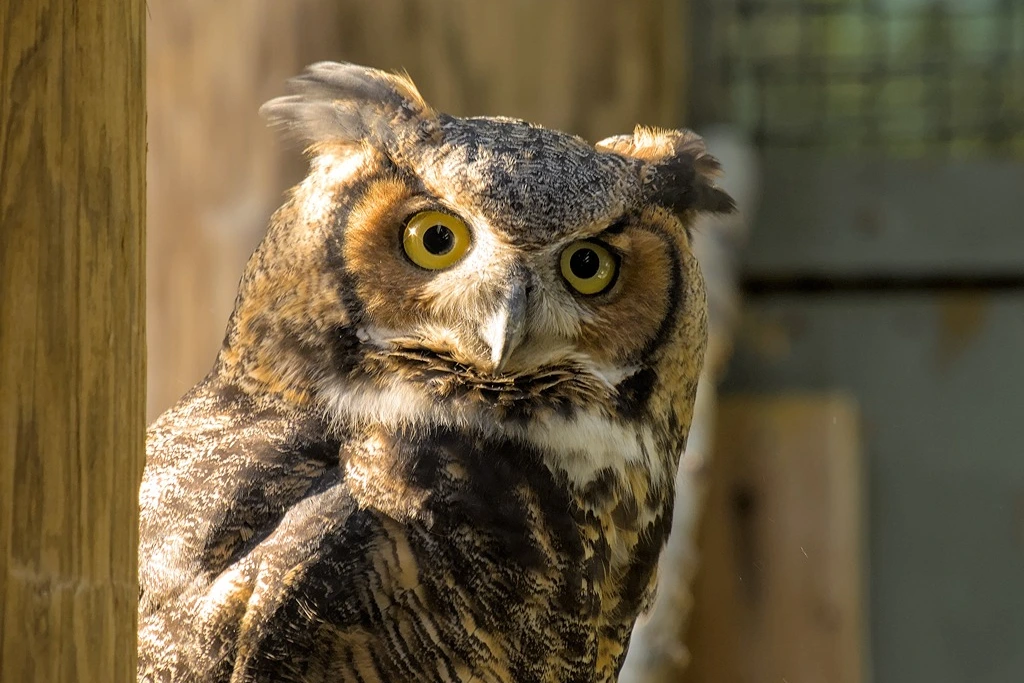
- Kingdom: Animalia
- Phylum: Chordata
- Class: Aves
- Order: Strigiformes
- Genus: Bubo
- Species: Bubo virginianus
- Length: 17 to 25 in (43 to 64 cm)
- Weight: 3.545 lb (1,608 g) for females and 2.698 lb (1,224 g ) for males
- Wingspan: 3 ft 0 in to 5 ft 0 in (91 to 153 cm)
Of the 13 species, what is the most common owl in Texas? The answer is the first in this article’s list: the great horned owl, or the hoot owl (Bubo virginianus). It is named for the horn-like feather tufts on its head. It is among the large owls in Texas, so you’re most likely to spot this one more frequently. It also helps that their call is the most associated sound with owls, the “who-who-who” sound.
Although you can find this species across Texas, they stay more often in the northern region. They’re often perched on tree branches, ready to pounce on a delicious cat, possum, rabbit, or skunk and turn it into a meal. Once in a while, they also hunt during the daytime, so you have an increased chance of sighting the great horned owl.
2. Barn Owl
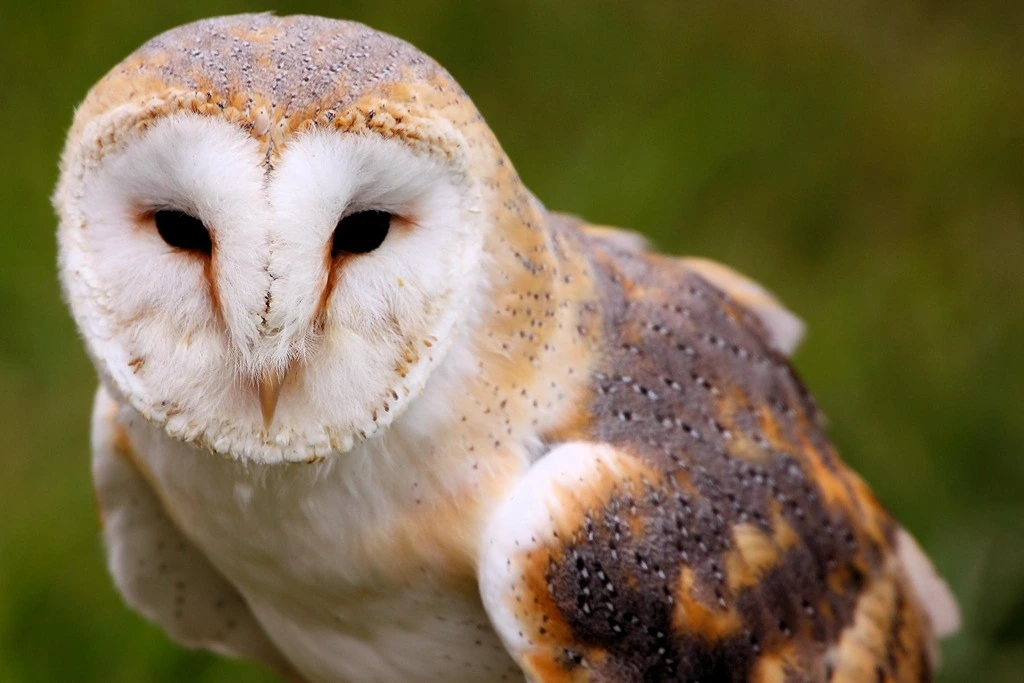
- Kingdom: Animalia
- Phylum: Chordata
- Class: Aves
- Order: Strigiformes
- Genus: Tyto
- Species: Tyto alba
- Length: 13 in and 15 in (33 cm and 39 cm)
- Weight: 15.17 oz to 21.87 oz (430g to 620g)
- Wingspan: 31 to 37 in (80 to 95 cm)
Does Houston have owls? They do, and one of them is the barn owls in Texas (Tyto alba). They’re one of the owl species you’d see less often than others because of habitat loss, which dwindles their population and affects survival rates. They’re also monogamous, so they’re unlikely to pair up with just any owl for breeding.
Barn owls have distinctive heart-shaped faces that are lighter than the feathers surrounding them, thus they are dubbed as “monkey-faced.” They’re also relatively small, medium at the most, making it harder to spot them. They do stand out for their light-colored coat, as they are one of the few white owls in Texas.
3. Flammulated Owl
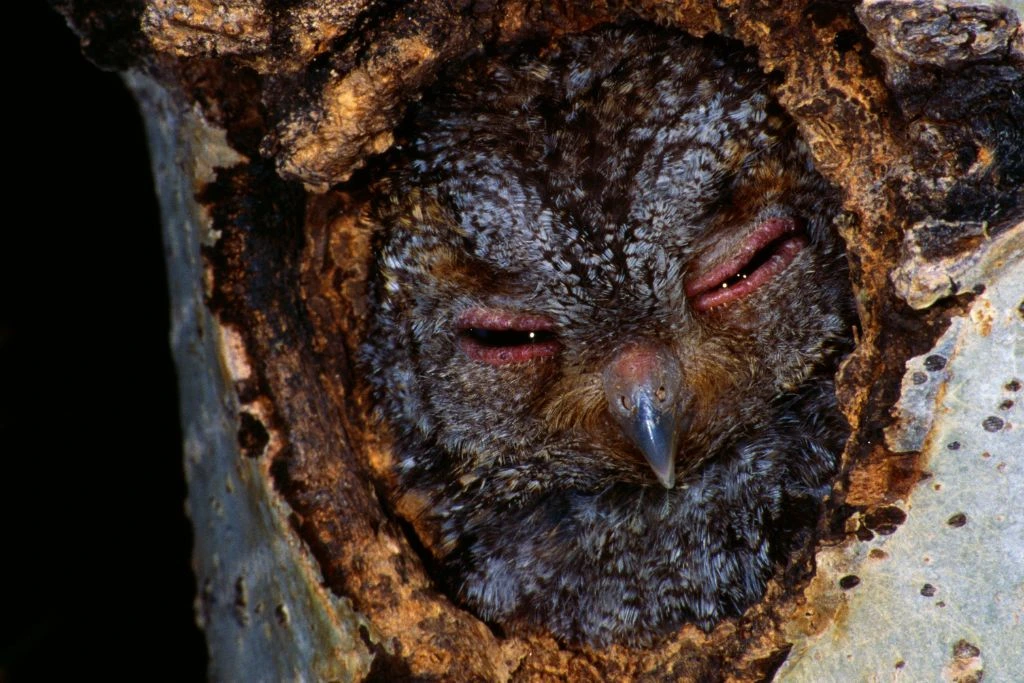
- Kingdom: Animalia
- Phylum: Chordata
- Class: Aves
- Order: Strigiformes
- Genus: Psiloscops
- Species: Psiloscops flammeolus
- Length: 6 in (17cm)
- Weight: 1.76 to 2.29 oz (50 to 65 g)
- Wingspan: 14 in (35.56 cm)
What do owls eat in Texas? The usual answers are rodents or small mammals, like mice and skunks. However, the flammulated owl (Psiloscops flammeolus), named for characteristic flame markings, stands out for its insectivore diet. They’re tiny owls, so insects are best for them, but they do eat small rodents sometimes.
Their size also makes them hard to find, just like barn owls. You can expect them in the western side of Texas, and they have a unique, low-pitched hoot, produced by their relatively large windpipes.
4. Western Screech Owl
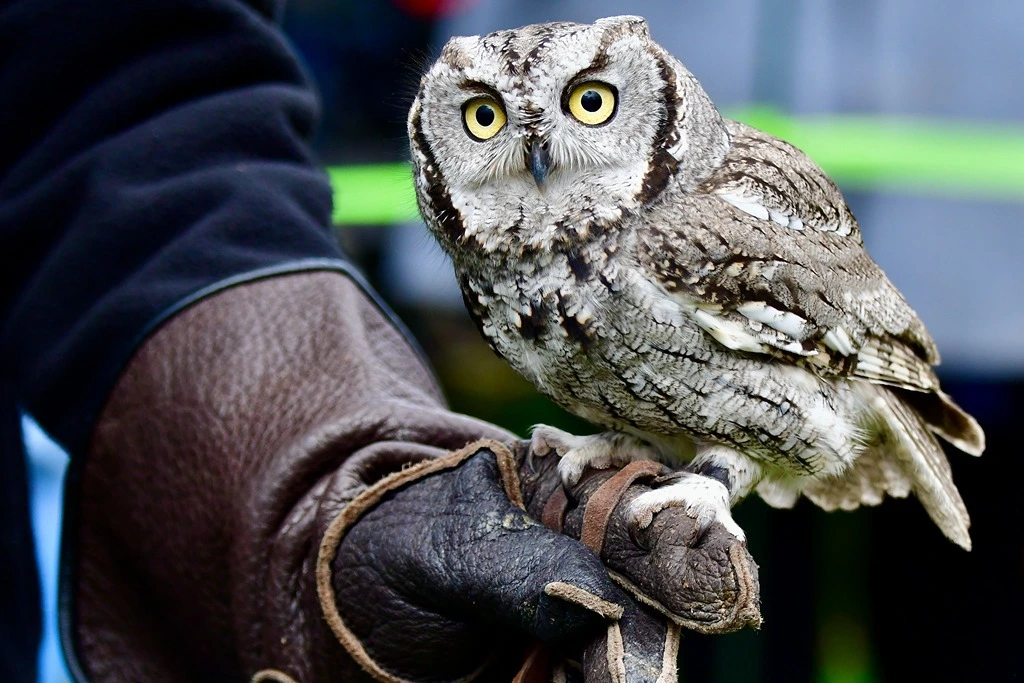
- Kingdom: Animalia
- Phylum: Chordata
- Class: Aves
- Order: Strigiformes
- Genus: Megascops
- Species: Megascops kennicottii
- Length: 8.7 in (22 cm)
- Weight: 3.1 to 7.8 oz (88 to 220 g)
- Wingspan: 22 in (55 cm)
Although we usually think owls say “hoot” or “who-who,” the western screech owls in Texas sound (Megascops kennicottii) like tooting horns. This call, and their brown plumage, differentiate them from the eastern screech owls. They exist in the west side of Texas, as well as in other states along the border.
Western screech owls are among the few types of owls who aren’t too shy with humans. What attracts these owls to your yard? They are mainly attracted to owl boxes, as they can use them as shelter. Other things that encourage owls to approach are bird baths, rodents, brush piles, darkness, perching spots, and plants.
5. Eastern Screech Owl
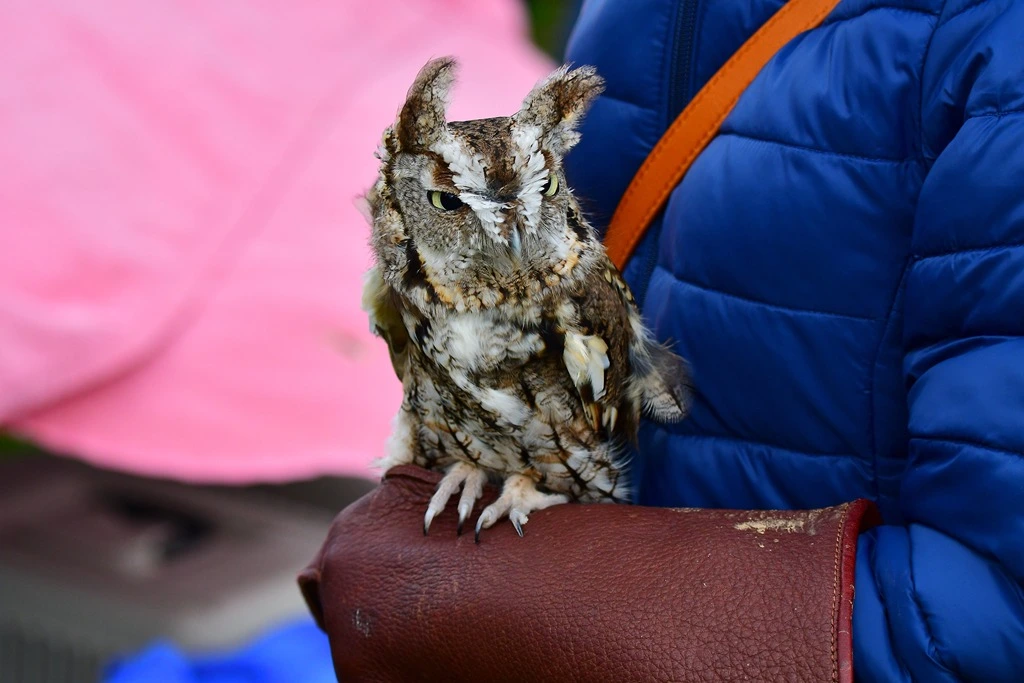
- Kingdom: Animalia
- Phylum: Chordata
- Class: Aves
- Order: Strigiformes
- Genus: Megascops
- Species: Megascops asio
- Length: 6.5 to 10 in (16 to 25 cm)
- Weight: 4.25–8.63 oz (121–244 g)
- Wingspan: 18 to 24 in (46 to 61 cm)
Are there owls in Dallas, Texas? Yes, there are, and they include the eastern screech owls (Megascops asio). You may also find these owls in Central Texas. They have a grayish to reddish plumage and are small. They have distinctive ear tufts on their heads that help with camouflage and communication, and they produce a trilling or whinnying sound, which you may hear at night. There are several morphs: gray McCall’s, red northern, gray northern, and brown northern.
Like their western counterparts, eastern screech owls are also comfortable residing near human homes. That might make you think, If they live near us, do owls like humans? Unfortunately, no. They’re still scared of us and will attack if threatened. What does it mean when this owl visits you? It means they find your place suitable for living because they can easily find food, shelter, or water (or all three) in your area. They prefer tree cavities but may use owl houses that you provide.
6. Ferruginous Pygmy Owl
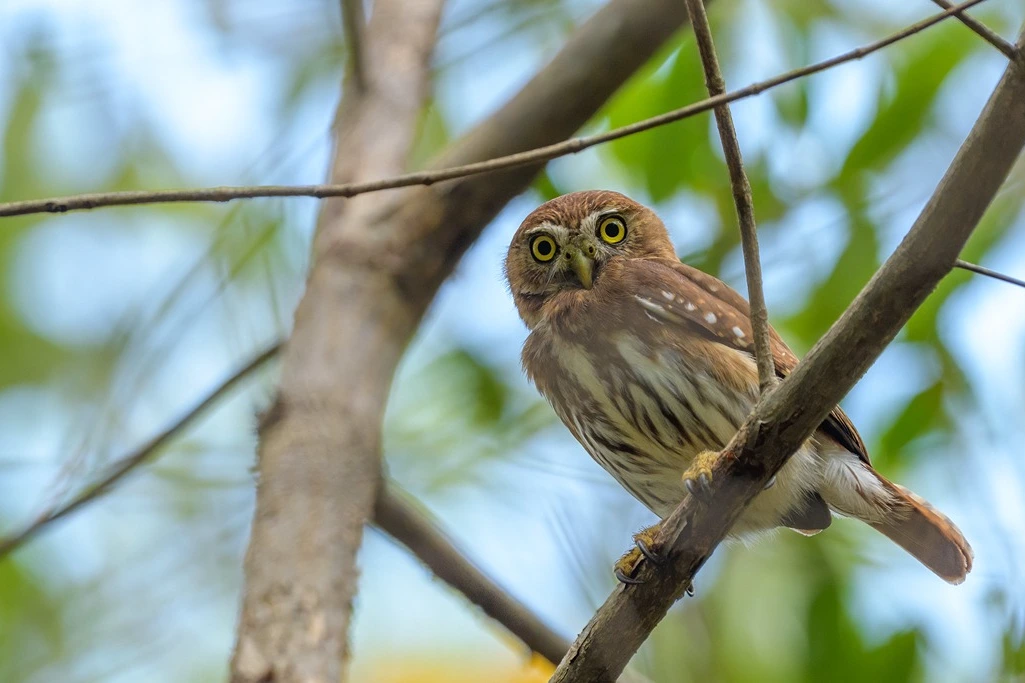
- Kingdom: Animalia
- Phylum: Chordata
- Class: Aves
- Order: Strigiformes
- Genus: Glaucidium
- Species: Glaucidium brasilianum
- Length: 6.5 – 7 in. (16.5 to 17.8 cm)
- Weight: 2.5 oz (70.9 g)
- Wingspan: 14.5 – 16 in. (36.8 to 40.6 cm)
The term “pygmy” is often used to describe tiny creatures, so a pygmy owl (Glaucidium brasilianum) is a small owl, especially compared to standard owl sizes. Ferruginous means reddish-brown or rust-colored. Thus, a ferruginous pygmy owl is essentially a tiny reddish-brown owl, although some variants aren’t rust-colored.
These pygmy owls are rare in the United States, so it’s pretty special for Texas to have them. They’re more prominent in Central and Southern America. They prefer residing in lowlands with mesquite trees.
7. Elf Owl
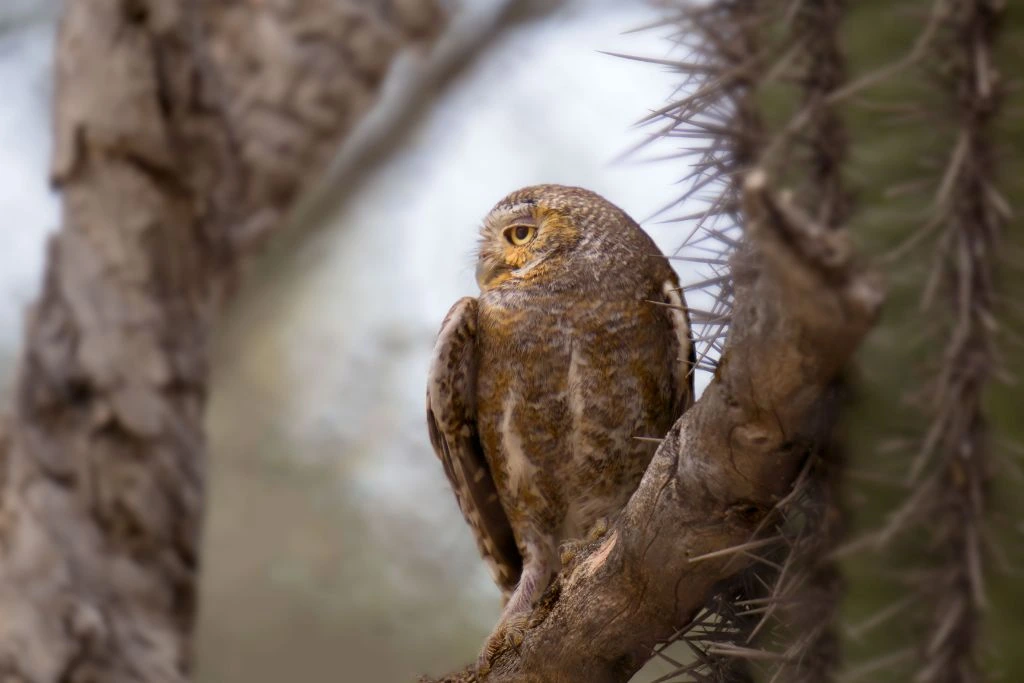
- Kingdom: Animalia
- Phylum: Chordata
- Class: Aves
- Order: Strigiformes
- Genus: Micrathene
- Species: Micrathene whitneyi
- Length: 4.9 to 5.7 in (12.5 to 14.5 cm)
- Weight: 1.4 oz to 21.87 oz (40 g)
- Wingspan: 10.5 in (27 cm)
While pygmy owls are tiny, elf owls (Micrathene whitneyi) are even more miniature! They’re usually less than six inches long, or 15.24 centimeters, making them the smallest owls on the continent. They have tiny bodies, so they can only consume insects, like centipedes and even scorpions (as long as the stinger is removed first).
Like the barn owl, the elf owl population is being threatened by habitat loss. This, coupled with their small build, makes it extremely rare to see one. They usually frequent the border of Texas and Mexico.
8. Burrowing Owl
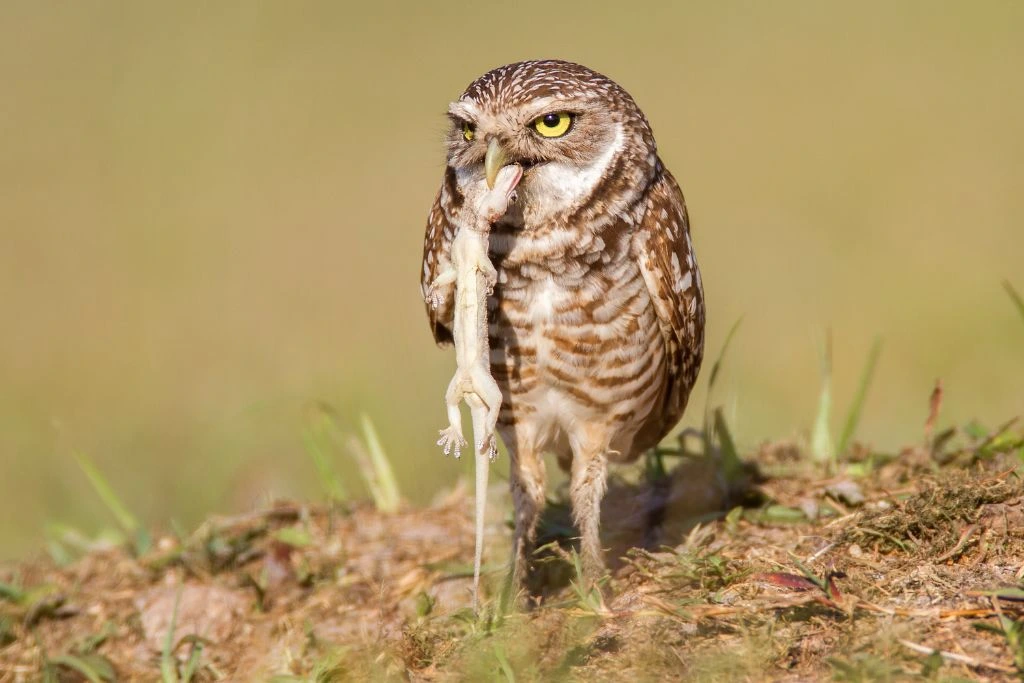
- Kingdom: Animalia
- Phylum: Chordata
- Class: Aves
- Order: Strigiformes
- Genus: Athene
- Species: Athene cunicularia
- Length: 7–11 in (19–28 cm)
- Weight: 5–8 oz (140–240 g)
- Wingspan: 20–24 in (50.8–61 cm)
While most owls enjoy perching on tree tops and branches, burrowing owls (Athene cunicularia) often claim abandoned animal tunnels for themselves. They are the only North American owl that can live underground, and that’s because they can tolerate high carbon dioxide levels. Besides animal tunnels, they have also turned PVC pipes and other human structures into their shelters.
Unlike most owls, this species is also more active during the day, so they are much easier to spot than other species. But such a fact, along with changes to their environment and animal predators, have caused their population to dwindle.
9. Barred Owl
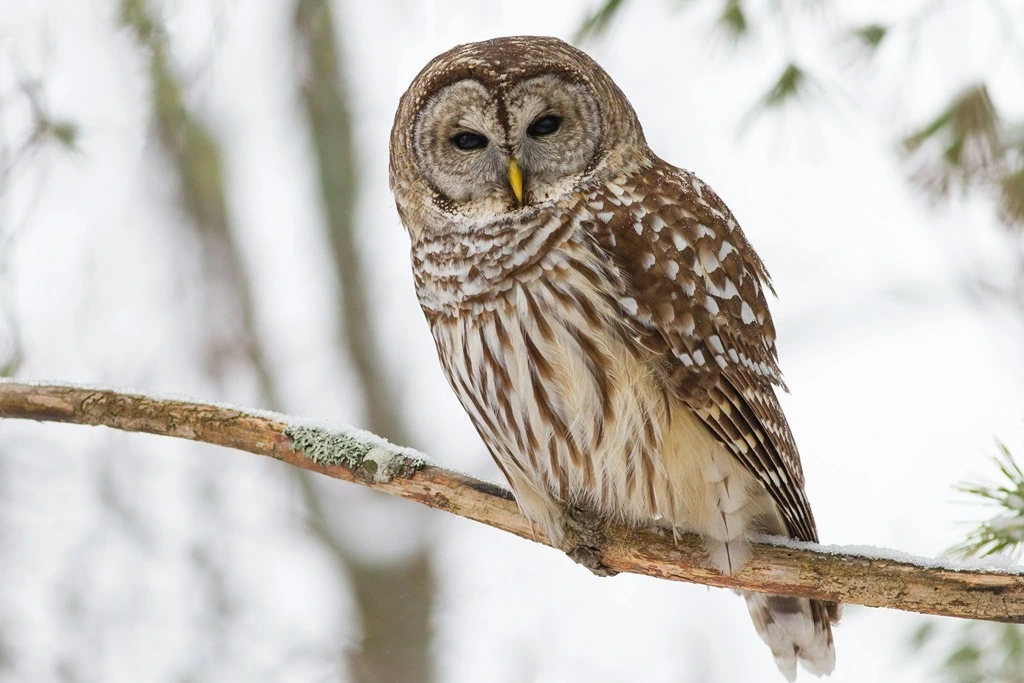
- Kingdom: Animalia
- Phylum: Chordata
- Class: Aves
- Order: Strigiformes
- Genus: Strix
- Species: Strix varia
- Length: 16 to 25 in (40 to 63 cm)
- Weight: 1.39 to 1.76 lb (630 to 800 g)
- Wingspan: 38 to 49 in (96 to 125 cm)
Have you ever heard an owl ask, “who cooks for you?” As weird as that sounds, that statement is actually what the barred owl’s (Strix varia) signature call sounds like. The barred owl is prominent in Texas’ eastern side and is named for its alternating horizontal brown stripes that appear like bars. Barred owls also have distinctly dark brown eyes.
They often compete for space with the spotted owls and are preyed upon by the great horned owl. Interestingly, they might approach you if you closely replicate its signature call. If you want them to stay away from you, what noises are owls afraid of? Some human noises that drive them away are yelling, clapping, stomping, and other abrupt, loud sounds.
10. Long-Eared Owl
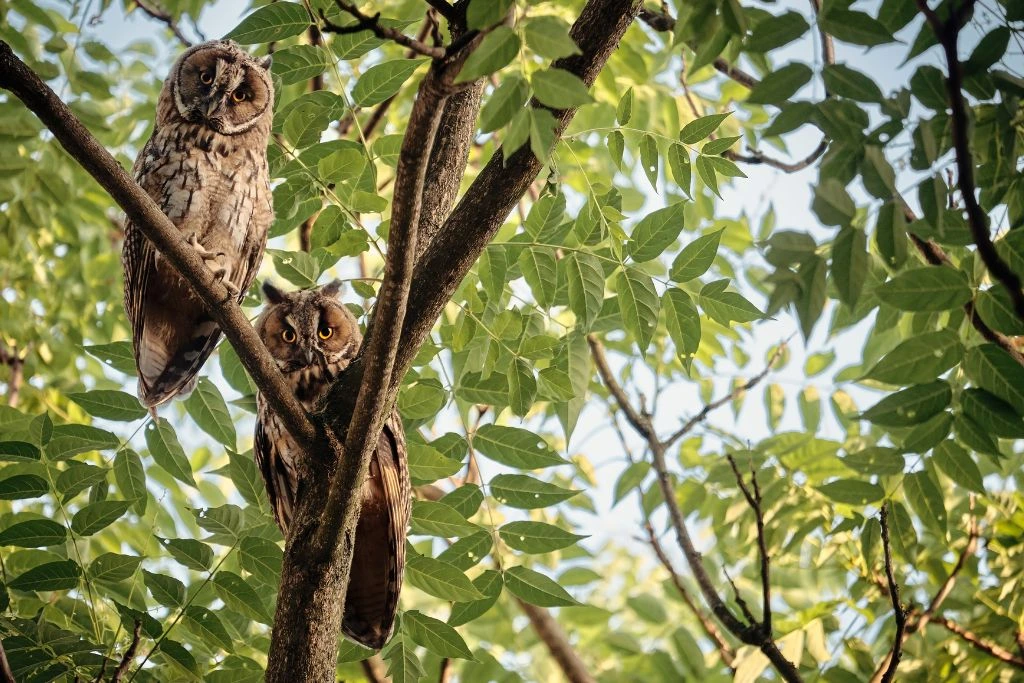
- Kingdom: Animalia
- Phylum: Chordata
- Class: Aves
- Order: Strigiformes
- Genus: Asio
- Species: Asio otus
- Length: 12 and 16 in (31 and 40 cm)
- Weight: 8.82 oz (250 g)
- Wingspan: 2 ft 10 in to 3 ft 4 in (86 to 102 cm)
If the name of this bird intrigues you, one look at it would explain why it’s called the long-eared owl (Asio otus). It has unusually long ear tufts, almost like animal or rabbit ears. Its facial features also resemble a cat’s, especially with its startled, large eyes; thus, they are also known as cat owls!
As magnificent as they look, catching sight of a long-eared owl is challenging for two main reasons. First, their feathers allow them to camouflage exceptionally well into their Western Texan environment. Second, they’re silent, even when flying, so you can’t even try to follow them by sound. However, they become noisier during mating season, so that’s the best time to try looking for them.
11. Short-Eared Owl
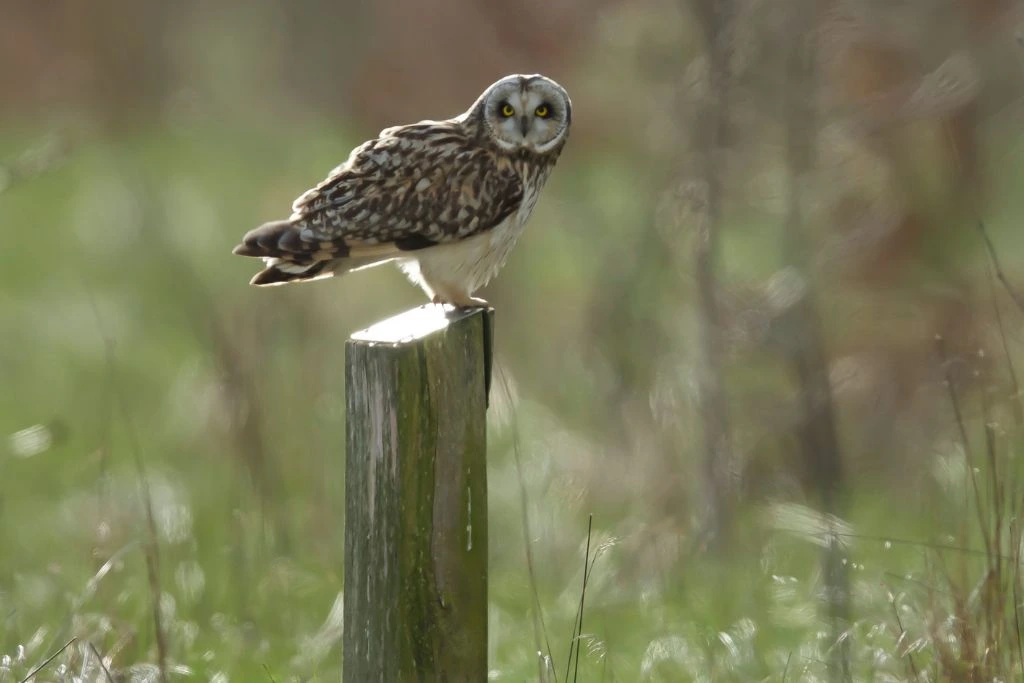
- Kingdom: Animalia
- Phylum: Chordata
- Class: Aves
- Order: Strigiformes
- Genus: Asio
- Species: Asio flammeus
- Length: 13–17 in (34–43 cm)
- Weight: 7.3–16.8 oz (206–475 g)
- Wingspan: 33 to 43 in (85 to 110 cm)
While long-eared owls have noticeably long and prominent ear tufts, the short-eared owls (Asio flammeus) are barely visible, hence the name. They’re also noted as migratory birds. They often come to Texas during winter and fly northward during the breeding season.
When they’re in Texas, the short-eared owls are often spotted along the Gulf of Mexico or the upper side of the state. You can consider it one of the few owls in North Texas. When they come over, they are pretty easy to spot as they’re active during daylight and are low-fliers. However, their habitats are being threatened, so much effort is needed to avoid seeing less of them over time.
12. Spotted Owl

- Kingdom: Animalia
- Phylum: Chordata
- Class: Aves
- Order: Strigiformes
- Genus: Strix
- Species: Strix occidentalis
- Length: 17 in (43 cm)
- Weight: 1.3 lb (600g)
- Wingspan: 45 in (114 cm)
The spotted owl (Strix occidentalis) is one of the most threatened species on this list. There are many reasons for this, starting with the fact that they share habitats with barred owls, which are often more aggressive than spotted owls and will often displace the latter. These two birds’ environments are also significantly changed by human development, leaving these birds with a smaller space and tighter competition.
Spotted owls don’t build their nests; instead, they use cavities or abandoned roosts. If there are none, it’s harder for them to increase. They are also monogamous. A spotted owl couple can take some time before they have chicks, so this infrequent breeding further leads to a declining population.
13. Northern Saw-Whet Owl
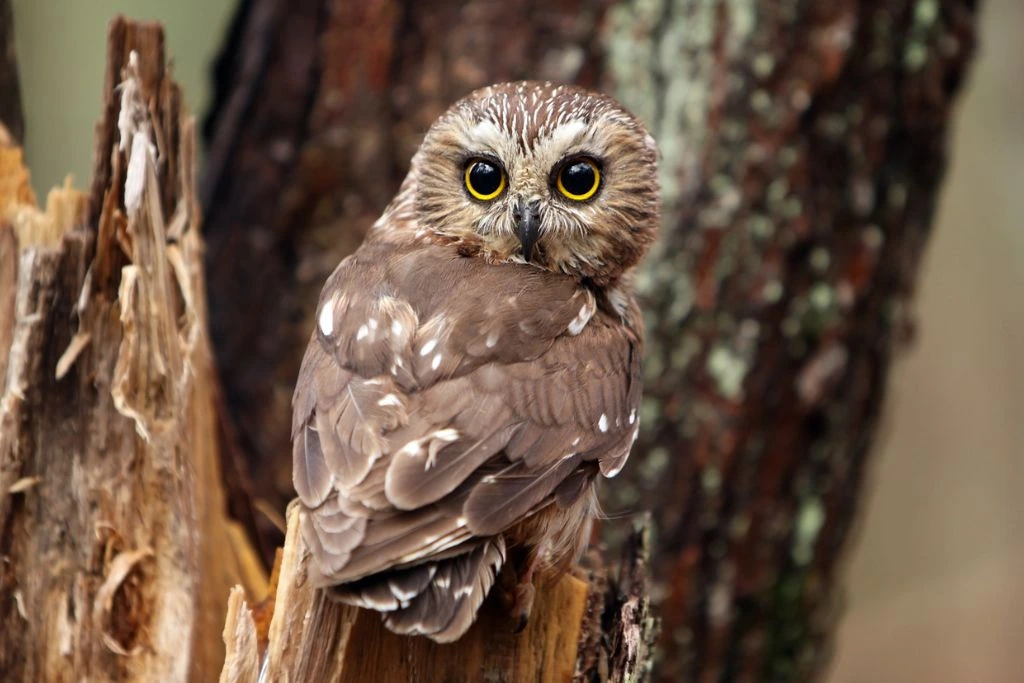
- Kingdom: Animalia
- Phylum: Chordata
- Class: Aves
- Order: Strigiformes
- Genus: Aegolius
- Species: Aegolius acadicus
- Length: 6.7–8.7 in (17–22 cm)
- Weight: 1.9 to 5.3 oz (54 to 151 g)
- Wingspan: 16.5–22.2 in (42–56.3 cm)
Like the long-eared owls, northern saw-whet owls (Aegolius acadicus) are described as having cat-like facial features. That might be because of their fierce, large, bright eyes. They’re also tiny, which makes their eyes appear even more prominent, and they have a signature “too-too” call. Besides the “too-too” call, they also make a call that sounds like a scraping saw, hence their name, saw-whet owl.
They’re most active at night, and that, combined with their small stature, makes it hard to see them. They take on abandoned nests of other birds, and if you put out owl boxes or nests, there’s a good chance they’ll take those, too.

